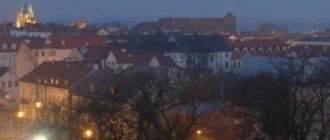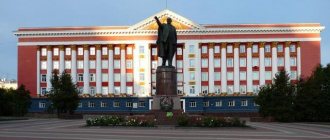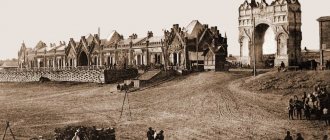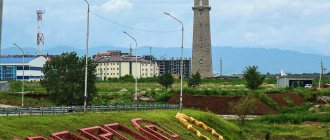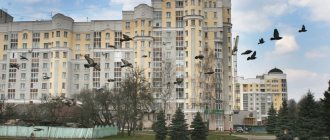This term has other meanings, see Svetlogorsk.
| city | |
| Svetlogorsk | |
| Belor. Svetlagorsk | |
| Flag[d] | Coat of arms[d] |
Svetlogorsk
Media files on Wikimedia CommonsSvetlogorsk
(Belorussian Svetlagorsk; until 1961 -
Shatsilki
or
Shatilki
) is a city of regional subordination in the Svetlogorsk district of the Gomel region of Belarus, the administrative center of the district. Population: 64,989 people (as of January 1, 2021)[3].
Content
- 1 Geography 1.1 Ecology
- 2.1 From origin to 1918
- 8.1 Television
Guest house "Breeze Baltic"
This not very expensive establishment is located in a calm and quiet area near the Baltic Sea. The rooms feature a rustic style and bright colors. There is satellite TV, access to wireless Wi-Fi, comfortable beds and deluxe rooms equipped with a safe.
The establishment has its own restaurant and barbecue facilities are available. The airport is only one and a half kilometers away. The area allows for recreational fishing and hiking.
Geography
The city is located in Gomel Polesie, a pier on the Berezina River. The distance by road to Gomel is 112 km (via the city of Rechitsa). Railway station on the Zhlobin - Kalinkovichi line.
The residential layout of the city consists of the following parts: Shatilki - along the river. Berezina, with predominantly individual buildings; so-called Old Town - blocks mainly with 2-3-story buildings from the 1950s - early 1960s; Stroiteley village - 1-storey building; 8 microdistricts that make up the main part of the city (see below); Neftyanikov village - 2-3-story buildings of the 1960s; Svetoch is the former village of Kakel and the territory of the manor house Elenpol, annexed to the city. The remaining places, which have mainly individual buildings, are along the railway, as well as adjacent to the village. Neftyaniki - do not have fully established names, although in relation to the latter the name “Old Airfield” is sometimes used.
The microdistricts have the following names: Oktyabrsky, Pervomaisky, Molodezhny, Yubileiny, Shatilki, Berezina, Polesie, Yuzhny. The Shatilki microdistrict is adjacent to Shatilki, the ancient part of the settlement. In the eastern part of the city there is an industrial zone.
Ecology
Svetlogorsk is considered one of the most unfavorable cities in the Republic of Belarus in terms of environmental conditions. In 2017-2018, complaints from local residents about air quality became more frequent. Local residents associate the complication of the environmental situation with the construction of a new bleached sulphate pulp plant by Chinese companies 2 km from the city limits and 500 m from the village of Yakimova Sloboda. In 2012, townspeople collected 10 thousand signatures against the construction of this plant. The enterprise was put into operation at the end of 2021, after which local residents began to complain about an unpleasant odor, suffocation, nausea, sore throat, and vomiting. Local authorities and representatives of the plant confirmed the fact of emissions, but called them temporary and associated them with forced adjustment of equipment in the process of reaching design capacity. It was emphasized that no excess of the maximum permissible concentrations of pollutants was found in the air samples. According to calculations by the Belarusian Research Institute, in the residential area of the city the concentrations of hydrogen sulfide, ammonia, formaldehyde should not exceed the maximum permissible concentrations, remaining at the level of 0.6-0.96 MAC (60%-96% of the permissible level). It is assumed that the strong smell of rotten cabbage that local residents felt was caused by mercaptans, the presence of which in the atmosphere had not previously been studied[5][6][7][8].
In January 2021, environmental activists revealed that the plant was discharging an unidentified liquid into the Berezina through storm drains, rather than through industrial sewerage and special treatment facilities[9].
In addition to the commissioning of the bleached sulphate pulp plant, the city is reconstructing the Svetlogorsk thermal power plant with the prospect of replacing expensive imported fuel with local peat, during the combustion of which ash is formed and falls on the ground[5].
Afterword
All these calculations are, of course, approximate and approximate. In a good way, I would buy an apartment in Svetlogorsk for the same 2,400,000 rubles, rent it out, find a job in Kaliningrad, and enter into shared-equity construction: now there are a lot of apartments for sale in new buildings in the suburbs of Kaliningrad for 850,000 rubles. In a year or two I would buy an apartment in Kaliningrad and then move permanently to Svetlogorsk. At the same time, already renting out Kaliningrad housing. Because life near the sea is, of course, great, but children grow up and they need entertainment, education, and career growth.
Story
From origin to 1918
Nozzles of a stove-house, XIII century.
According to the results of archaeological excavations, a settlement on the site of the modern city existed from the 7th century, a cultural layer of the early Middle Ages was discovered, with objects of the Hun-Avar type[10]. Since the 13th century, according to archaeological data, the settlement has existed continuously[11].
Priviley to Shatilinsky Island 1560
Name Shatilki
- patronomic origin from the surname
Shatilo
[12].
According to a written source, the settlement has been known since July 15, 1560 as the estate of Shatilinsky Island
, in the Grand Duchy of Lithuania (GDL).
As evidenced by the document - privileges of the King of Poland and Grand Duke of Lithuania Sigismund II Augustus, issued in Warsaw, the estate, after the previous owner Roman Shatila, was transferred to Zemyan Zhdan Mankiewicz for performing military service[13][14]. In 1566, the settlement became part of the created Rechitsa Povet of the Minsk Voivodeship of the Grand Duchy of Lithuania. "Lubich" is the coat of arms of the Mankiewicz family.
From July 1, 1569, as a result of the unification of the Grand Duchy of Lithuania and the Kingdom of Poland - in the Polish-Lithuanian Commonwealth. In 1639 in the village of Shatilovichi
[15] 17 peasant households (nobles were not included in the inventory), in the Bobruisk eldership of the Rechitsa povet[16].
Around 1650 a church was founded here[17]. (Previously, its foundation was attributed to 1638[18], but this was not confirmed[19].) In 1744, Shatilki
, in the Karpilovich parish of the Bobruisk deanery of the Vilna diacey[20].
Since 1793, after the second partition of the Polish-Lithuanian Commonwealth, settlement in the Russian Empire. It was part of the Parichskaya volost of the Bobruisk district of the Minsk province. In 1795 there were 30 households in Shatilki[21]; in 1800 there were 23 households, of which 20 were gentry. In 1797, the Parichi estate and Shatilki related to it were transferred by Emperor Paul I to captain (later lieutenant general) Ivan Petrovich Pushchin. Orthodox residents belonged to the St. Peter and Paul parish of Cirkovichi (1879)[22]. In 1890 - 49 courtyards, a pier[23]. At the beginning of the 20th century the population was 713 people. In 1915, a railway was built near Shatilki and a station was established[24][25].
From 1918 to the present time
After the conclusion of the Brest Peace Treaty, the city was occupied by German troops, and the Belarusian People's Republic was proclaimed on the occupied territory; after the surrender of Germany in November 1918 and the withdrawal of its troops in early December 1918, the BPR ceased to exist, the city came under the control of the Soviets and became part of the Belarusian Soviet Socialist Republic, proclaimed on January 1, 1919, from February 27, 1919 - in the Lithuanian-Belarusian Soviet Socialist Republic, from July 31, 1920 - again in the BSSR, which was part of the USSR from December 30, 1922 to December 26, 1991, from September 19, 1991 - the Republic of Belarus.
In 1921, the Minsk province was liquidated, and its districts (including Bobruisk) began to be included directly in the BSSR. On August 20, 1924, the volosts (including Parichskaya) and counties were liquidated. From this day on, the town of Shatsilki
- the center of the village council (until 1960) in the created Parichsky district [26], which is part of the Bobruisk district (existed until July 26, 1930), and then: from February 20, 1938 - to Polesskaya, from April 20, 1944 - to Bobruisk, from January 8, 1954 - to the Gomel region.
Shatsilki
railway station was included in the Chirkovichi village council of the Parichi district.
In 1929-1932. A shipyard was created in Shatilki (now a prefabricated reinforced concrete plant). On September 27, 1938, shtetls as a type of settlement in Belarus were abolished, and Shatilki was classified as a village. In 1939, the village of Orekhovka
and the village
of Zaivanov
.
The village was also annexed to Shatilki. Red Banner
(no information about the village council) [27] and
Awakening
(Shatilkovsky village council).
In 1954-1958 Vasilevichskaya GRES was built in Shatilki. The name of the station was given after the peat deposit near the town of Vasilevichi in the neighboring Rechitsa region (now Svetlogorsk Thermal Power Plant). On December 30, 1956, the village of Shatilki was transformed into an urban settlement; from June 9, 1960 - the center of the Parichi district. On July 29, 1961, the urban village of Shatilki was transformed into the city of Svetlogorsk, and the Parichsky district was renamed Svetlogorsk[28]. The new name was intended to symbolize the bright life of the new, Soviet Polesie[12]. On December 1, 1966, the Shatilki railway station was annexed to the city[27], and on July 10, 1975, the village of Svetoch
(until December 4, 1964 -
Kakal
)[29].
Interesting objects
There are enough attractions in the city of Svetlogorsk, Kaliningrad region. The most important ones are listed below:
- Statue of the frog princess. This sculpture is located in the park near the railway station. It was opened on August 11, 2006. It represents a woman sitting on a stone in a frog pose. This sculpture was created over 20 years by the same artist and is made of bronze. This is a kind of symbol of the city and a talisman of good luck.
- Sculpture "Carrying Water". This is a marble statue depicting a girl carrying water in a jug. It was created in 1944. Another name is “Girl with a Jug.” Gradually, the statue began to deteriorate, and therefore it was transported to the museum, and an exact copy was placed in the same place.
- Monument to Academician Pavlov.
- Organ Hall.
- Sundial.
- A female sculpture called “Nymph” on the city embankment.
- Eagle statue.
- Memorial sign to Thomas Mann. It is a stone image of an open book lying on a stone.
- Pedestrian path "Promenade".
- The hydropathic tower.
- Lutheran Church, built in 1907.
- Monument to Hoffmann. It is displayed at the House of Storyteller hotel.
- Memorial complex at the grave of Soviet soldiers. 75 people who died in January-April 1945 are buried there. There is also a monument there. All this was done during Soviet times.
In addition to all this, the city has many interesting architectural structures.
Population
Population by year
| 1917 | 1953 | 1959 | 1961 | 1970 | 1973 | 1975 | 1993 | 2001 | 2006 | 2008 | 2009 | 2010 | 2011 | 2014 | 2015 | 2016 | 2017 | 2018 | 2019 | 2020 | 2021 |
| 0,757[21] | 2,170[30] | 5,772[31] | 11,5[32] | 40,3[33] | 48,7[33] | 55[34] | 74[35] | 73,4[33] | 70,2 | 69,5 | 69,3 | 69,9 | 69,5[36] | 68,7[36] | 68,6[36] | 69[36] | 68,6[36] | 67,5[36] | 67,1[37] | 65,5[38] | 64,989[3] |
(thousand people)
| National composition according to the 2009 census | ||
| People | Number | % |
| Belarusians | 31 281 | 87,55 % |
| Russians | 6697 | 9,57 % |
| Ukrainians | 1294 | 1,85 % |
| Poles | 210 | 0,3 % |
| Gypsies | 69 | 0,1 % |
| Jews | 45 | 0,06 % |
| Tatars | 35 | 0,05 % |
| Armenians | 25 | 0,04 % |
| Moldovans | 25 | 0,04 % |
| Uzbeks | 20 | 0,03 % |
| Azerbaijanis | 14 | 0,02 % |
| Germans | 13 | 0,02 % |
| Lithuanians | 10 | 0,01 % |
In 2021, 690 people were born and 859 people died in Svetlogorsk. Birth rate - 10.1 per 1000 people (average for the district - 10.5, for the Gomel region - 11.3, for the Republic of Belarus - 10.8), mortality rate - 12.6 per 1000 people (average for the region - 15.1, in the Gomel region - 13, in the Republic of Belarus - 12.6). The natural population decline (-2.5 per 1000 people) is one of the highest among the regional centers of the Gomel region. A higher rate of natural population decline in 2021 was noted only in Vetka, Petrikov and Dobrush[39]. In terms of the birth rate in 2021, the city shared 14th-16th place with Bobruisk and Polotsk among 23 cities in the country with a population of more than 50 thousand people; in terms of mortality rate, the city took 2nd place, in terms of natural population growth/decrease (-2. 5) - 22nd (a more significant population decline was noted only in Orsha)[40].
Svetlogorsk - 2
Svetlogorsk-2. Collage of landmarks. Photo by iren.koroleva2012 (https://fotki.yandex.ru/users/iren-koroleva2012)
This part, in fact, is the resort itself - everything here is focused on the recreation industry. It is full of boarding houses, hotels, restaurants, cafes and more. But there are no schools or kindergartens here - there are a couple of private ones.
Housing is expensive: for example, a two-room apartment of 60 sq. m. in a new building it will cost about 5 million rubles. But it happens that you might get lucky and be able to buy something for 2 million - 2.5 million rubles in an old, still German housing stock.
Renting housing in this part of Svetlogorsk is a pleasure for visiting holidaymakers. The cost is usually charged daily: from 2300 rubles. up to 4000 rub. If you rent for a long time, then the average price for a two-room apartment will be from 20,000 rubles. up to 50,000 rub/month. In winter, prices drop by about 20%.
Rent, as a rule, includes housing and communal services. A gas pipeline has been laid in Svetlogorsk, the cost of natural gas per cubic meter. — 7.83 rub. The average amount for a communal apartment in the summer is 1,800 rubles. in winter −2600 rub. (with autonomous heating) - 5240 rubles (with central heating).
Authorities
Representative body
is
the Svetlogorsk District Council of Deputies
.
It consists of 40 people and is elected by residents in single-member constituencies. The term of office is 4 years. The Council of Deputies of the 28th convocation was elected on February 18, 2021. The chairman of the council is Lyudmila Filippovna Velichko. The executive and administrative authority
is
the Svetlogorsk District Executive Committee
. On September 14, 2021, the President of the Republic of Belarus agreed to the appointment of Dmitry Vadimovich Aleynikov as Chairman of the Svetlogorsk District Executive Committee.
Economy
Winding of heat-resistant Arselon thread produced by OJSC SvetlogorskKhimvolokno.
Largest enterprises:
- OJSC "SvetlogorskKhimvolokno"
- Svetlogorsk Pulp and Cardboard Mill (SPCC) bleached sulphate pulp plant (new)
The Svetlogorsk Machine-Building Plant is located in the village of Sosnovy Bor, 15 km south of Svetlogorsk[41].
Guest House "Flamingo"
This establishment is located in one of the picturesque areas of Svetlogorsk. The rooms have comfortable furniture and modern appliances, and a bathroom. The guest house has a café serving delicious meals, drinks and snacks. It is possible to cook food on the grill.
There is parking near the building. There is also a sauna, billiard room, and a common room with TV. In the vicinity of the guest house there are museums, a central park, and the Makarov organ hall. The distance to the sea is quite significant - about 1 kilometer.
Most recently (in 2021), the building was completely renovated.
Education
There are 12 secondary schools in the city, including a gymnasium; interschool training and production plant; 1 vocational institution.
There is an industrial college (founded in 1960 as a branch of the Molodechno Polytechnic School, and since 1966 - the Svetlogorsk Industrial College)[42].
There is a house for children and youth creativity, a children's art school and a children's art school.
There is a sports complex, a swimming pool, 3 stadiums, and a tennis court.
Climate
The climate in the city is largely determined by where Svetlogorsk is located. It is maritime, with an average annual temperature of +6.8 °C. Winters are cool and mild, summers are warm. In winter there is unstable snow cover. The annual precipitation is 911 mm. The driest period of the year is spring.
Many people are interested in the question: on what sea is Svetlogorsk located? This city is located on the southern shore of the Baltic Sea, the climate of which is significantly different from the climate of the Black Sea. It is not hot here, and the sun is not so scorching. Cloudy days occur more often.
Culture
Railway station (formed in 1915)
The city operates:
- State cultural institution “Svetlogorsk regional network of libraries”
https://svetlib.gomel.by/ [43] provides users with free and equal access to library collections and information resources, provides library, information and reference and bibliographic services to users, taking into account their needs, organizes cultural and educational work aimed at meeting the spiritual and cultural needs of members of society.
Library services to the population
are provided by 26 libraries, including 7 city, 2 city, and 17 rural.
There are 22 non-stationary library points, and 27 settlements are served through the library bus. are computerized
, 26 have Internet access.
Four libraries provide user services in an automated manner. Users of the Svetlogorsk regional network of libraries are more than 31 thousand people, including 15 thousand children. The number of visits annually is more than 300 thousand, the number of books issued is 500 thousand copies.
388 thousand copies
are available to users fund, self-generated databases, electronic catalog with a volume of 124 thousand records. Libraries provide access
to information resources of the largest libraries of the republic: NLB, RSTL, Central Scientific Library of the National Academy of Sciences named after. Y. Kolas, Gomel Regional Library, as well as the possibility of using virtual reference services and electronic delivery of documents. The Svetlogorsk regional network of libraries is included in the partner organizations of the National Library of Belarus. Legal information support for users is provided by 6 Legal Information Centers. Library institutions provide 50 types of additional paid services. The work of 34 amateur associations is organized, 26 of which are for children. The number of members of club associations is more than 600 people. - Museum of Toys of the World
at the branch "City Children's Library No. 3" https://svetlib.gomel.by/toy-museum-of-the-world[44] - Corner of Japanese culture
at the branch of the "Children's District Network of Libraries" https://svetlib.gomel.by/japanese-c[44]orner/ - City Museum of History and Local Lore
- House of Crafts
- City Art Gallery "Tradition" named after. G. Pryanishnikova
- Svetlogorsk Cultural Center (SCC)
- House of Culture for Power Engineers (DKE)
- State cultural institution "Svetlogorsk Folk Art Center" (SCNT)
Hotel "Lumiere"
This respectable hotel is located in a forest area, close to the coast and not far from the city center. There are 20 places for people to live. All rooms are beautifully decorated. One to three people can live in one room. There are also deluxe rooms. Bathrooms are well equipped.
There is no need to buy food at the store. The hotel has its own restaurant where Russian and European dishes are prepared. You can order a diet menu. Plus, food and drinks can be delivered to your room and packaged food can be purchased for the trip.
In addition to the restaurant, the hotel has a Russian bath, sauna, laundry, car and bicycle rental. There are also barbecue areas, a children's playground, a library, parking, and Wi-Fi. Near the hotel there are restaurants, cinemas and shops.
Partner cities and district
- Obzor (Nessebar community, Burgas region, Bulgaria).
- Bielsk-Podlaski (Bielsk County, Podlaskie Voivodeship, Poland).
- Ivanteevka (Moscow region, Russia).
- Kommunar (Gatchina district, Leningrad region, Russia).
- Kingisepp (Kingisepp district, Leningrad region, Russia).
- Calarash city (Calarash district, Moldova).
- Calarasi town (Calarasi county, Romania).
- Helmstedt (Helmstedt district, Lower Saxony, Germany).
- Chernushka (Chernushinsky district, Perm region, Russia).
- Mendip County (Somerset, South West England, England, UK).
Notes
- Executive Committee Leadership
- Decision of the Gomel Regional Council of Deputies dated September 27, 2011 No. 137 On establishing the boundaries of the city of Svetlogorsk, Gomel Region
- ↑ 123
Population as of January 1, 2021 and the average annual population for 2021 in the Republic of Belarus by regions, districts, cities, urban-type settlements (Russian). National Statistical Committee of the Republic of Belarus. Date accessed: July 9, 2021. Archived April 18, 2021. - Svetlogorsk - list of streets. (unspecified)
(inaccessible link). Access date: September 19, 2009. Archived October 18, 2015. - ↑ 1 2
Residents of Svetlogorsk fear a sharp deterioration in the environmental situation in the region (Russian).
TUT.BY.
_ Date accessed: June 27, 2021. Archived April 20, 2012. - Germanovich A.
The authorities are trying to convince the population that the pulp plant stinks within normal limits (Russian) (January 10, 2018). - Why does Svetlogorsk stink again? Official response from the representative of the Central Control Commission (Russian). lovesun.by
(July 31, 2018). - Vasilevskaya A.
“The stench gets stronger every day.” The scandal over the plant in Svetlogorsk is gaining momentum, the director “does not smell” (Russian) (inaccessible link). TUT.BY (September 15, 2018). Date accessed: June 27, 2021. Archived November 5, 2021. - Germanovich A.
“Smelly” plant in Svetlogorsk pours some nasty stuff into the lake (Russian) (January 21, 2019). - Objects from antiquity were found in Svetlogorsk inaccessible
link). Date accessed: December 21, 2009. Archived March 4, 2021. - Rassadin S.E.
About some finds of 2008 on Shatilinsky Island // Studies on the history of Eastern Europe: scientific collection. - Mn., 2008. - P. 234-236. - ↑ 12
Zhuchkevich, 1974, p. 336. - From the history of Shatsilavich (unspecified)
(inaccessible link). Access date: June 4, 2010. Archived April 11, 2012. - Maslyuko T.V.
From the history of Shatsilavich // Gomelshchyna: old minutes. - Gomel, 1996. - pp. 22-26. - Belor. Shats is a good, beautiful place, in V.I. Dahl’s dictionary it means “a mountain of medium size.”
- Kernazhytskiy K.
Agrarian reform in the Babruisk eldership and the economic development of the population from the 17th to the 19th century. - Mn., 1931. - Shatsilavichs // The Great Principality of Lithuania: Encyclopedia. U 3 vol. - Mn., 2005. - T. 2. - P. 754. - ISBN 985-11-0378-0.
- Blinova T. B.
Babruisk Jesuit Residence // Encyclopedic history of Belarus. U 6 vol. - Mn., 1993. - T. 1. - P. 255. - ISBN 5-85700-074-2. - Maslyuko T. V.
Attempted storage of cascel on Nizhnyaya Byarezina // Shatsilka's readings: materials of the 2nd historical conference (and 450-year-old Shatsilak) at Svetlagorsk, 15 beautiful 2 010 - Svetlagorsk, 2011. - P. 38-50. - Diecezja Wilenska, 1744 // Suwalskie Towarzystwo Genealogiczne im. prof. J. Wisniewskiego. (Polish)
- ↑ 1 2 Duleba G. I., Kurylovich G. M.
Svetlagorsk // Memory: Svetlagorsk. Svetlagorsk district. At 2 books. Book 2. - Mn., 2003. - P. 741-742. — ISBN 985-01-0255-1. - Recorded church of Svetlagorshchyny // Memory: Svetlagorsk. Svetlagorsk district. At 2 books. Book 1. - Mn., 2000. - P. 77-85. — ISBN 985-01-0254-3.
- Jelski A.
Szaciłki // Słownik geograficzny Królestwa Polskiego i innych krajów słowiańskich. - Warszawa, 1890. - S. 755. - Kishtymov A.
Stages of railway construction in Belarus // Gistarychny Almanac. - 2002. - T. 7. - Stages of railway construction in Belarus (unspecified)
(inaccessible link). Access date: June 2, 2010. Archived September 16, 2011. - Kaminski M. I., Pyatrosava A. Yu.
Svetlagorsk // Collection of memories of the history and culture of Belarus. Gomel region. - Mn., 1985. - P. 334. - ↑ 1 2 Duleba G. I., Kurylovich G. M.
Ab settlements that are no longer known and renamed // Memory: Svetlagorsk. Svetlagorsk district. At 2 books. Book 2. - Mn., 2003. - P. 742-748. — ISBN 985-01-0255-1. - Decree of the Presidium of the Supreme Council of the BSSR dated July 29, 1961 “On the transformation of the urban village of Shatilki into a city of regional subordination and the renaming of the Parichsky district of the Gomel region.” (Russian) (inaccessible link). Access date: July 23, 2010. Archived December 24, 2013.
- Ramantsov V.
Known Land. - Mn., 2011. - P. 72-73. — ISBN 978-985-6906-52-0. - Khomich A. M., Rabyanok P. P.
Svetlagorsk at the Ryshtavannyakh // Memory: Svetlagorsk. Svetlagorsk district. At 2 books. Book 2. - Mn., 2003. - P. 541-555. — ISBN 985-01-0255-1. - The actual population of cities and other settlements, districts, regional centers and large rural settlements as of January 15, 1959 by republic, territory and region. Byelorussian SSR. (Russian) (inaccessible link). Access date: June 6, 2010. Archived May 30, 2010.
- Svetlogorsk // Brief geographical encyclopedia. - M., 1962. - T. 3.
- ↑ 123
Svetlagorsk // Belarusian Encyclopedia: U 18 vol. T. 14: Rele - Slayavina (Belarusian) / Editorial: G. P. Pashkov and others. - Mn.: BelEn, 2002. - P. 253. - 10,000 copies. — ISBN 985-11-0238-5. - Svetlogorsk
- article from the Great Soviet Encyclopedia. - Svetlogorsk // Big Encyclopedic Dictionary (Russian). - 2000.
- ↑ 123456
Statistical yearbook of the Gomel region. - Mn.: National Statistical Committee of the Republic of Belarus, 2021. - P. 47. - Statistical yearbook of the Gomel region 2021.
- Population as of January 1, 2021 for the Republic of Belarus by regions, districts, cities, urban-type settlements (Russian). National Statistical Committee of the Republic of Belarus.
- Demographic Yearbook, 2021, p. 164-166.
- Demographic Yearbook, 2021, p. 157-174.
- Shcherbakov Z.
Svetlogorsk Machine-Building Plant wants to leave the Gomselmash holding (Russian) (inaccessible link). BelaPAN (June 18, 2015). Date accessed: June 27, 2021. Archived June 27, 2021. - Svetlagorsk industrial technical school // Belarusian Encyclopedia: U 18 vol. T. 14: Relay - Slayavina (Belarus) / Editorial: G. P. Pashkov and others. - Mn.: BelEn, 2002. - P. 253. - 10,000 copies. — ISBN 985-11-0238-5.
- https://svetlib.gomel.by/ (Russian) (undefined)
. Date accessed: August 30, 2021. - ↑ 1 2
toy museum of the world (Russian)
(undefined)
. Date accessed: August 30, 2021. - Ranak.me page with contact details (Russian) (undefined)
. - Website page of the newspaper “Svetlagorskaya naviny” with contact information (Russian) (undefined)
. - About the regionality of the site lovesun.by (Russian) (undefined)
. - Svetlagorsk - parish of the Uzvyshennya Svyatoga Kryzha (Belarusian). Access date: June 27, 2010.
- Hotel Svetoch (Russian). Housing and communal services of the Gomel region. Date accessed: August 25, 2021. Archived September 15, 2021.
- Hotel OJSC "SvetlogorskKhimvolokno" - OJSC "SvetlogorskKhimvolokno" (Russian). Date accessed: August 3, 2018.
- Hotel ZhBIiK (Russian). Date accessed: August 25, 2021. Archived November 5, 2021.
- A five-story hotel is up for auction in Svetlogorsk (Russian). Interfax-West (January 12, 2020).

